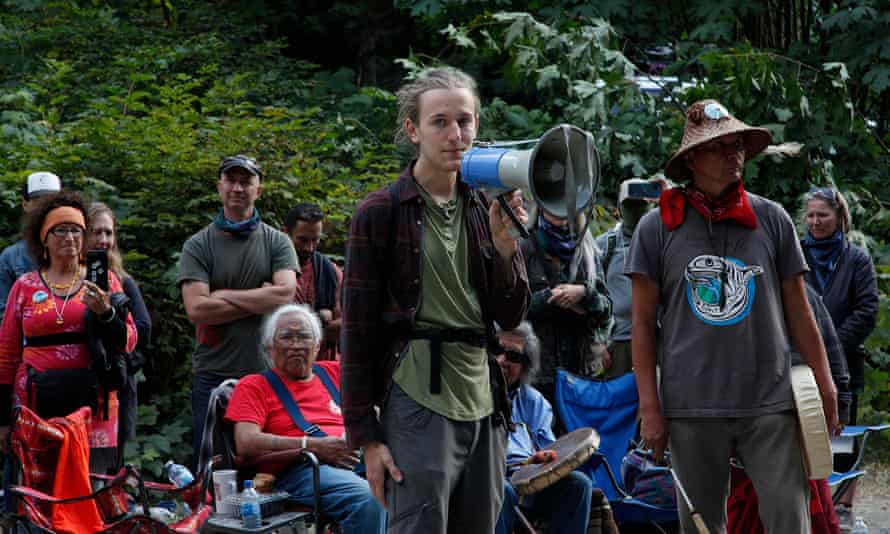Anti-logging protest becomes Canada’s biggest ever act of civil disobedience
At least 866 arrested since April, as police condemned for violence against protesters defending Vancouver Island’s ancient forests
![Protesters on the floor of the logging road. One protester said: 'The [police] are getting very frustrated by our tenacity because we're constantly rebuilding and coming up with new ideas.'](https://i.guim.co.uk/img/media/787019e2856f508a9929f91fac2efef3edd32d54/0_48_1440_864/master/1440.jpg?width=445&quality=45&auto=format&fit=max&dpr=2&s=83cffca10d24ab765cb0f76985dbcbbb)
Last modified on Wed 8 Sep 2021 11.39 EDT
A string of protests against old-growth logging in western Canada have become the biggest act of civil disobedience in the country’s history, with the arrest of least 866 people since April.
The bitter fight over the future of Vancouver Island’s diminishing ancient forests – in which activists used guerrilla methods of resistance such as locking their bodies to the logging road and police responded by beating, dragging and pepper-spraying demonstrators – has surpassed the previous record of arrests set in the 1990s at the anti-logging protests dubbed the “War in the Woods”.
For months, hundreds of activists with the Rainforest Flying Squad have camped out in the remote Fairy Creek watershed in a desperate attempt to shift the course of logging in the region.
They have chained themselves to tripods crafted from logs, suspended themselves in trees and even locked their arms inside devices called “sleeping dragons” cemented into the ground.
“We have experts in rigging, we have climbers, we have carpenters – we have all these people getting together to build amazing, beautiful things,” said Jean-Francois Savard, who has been at the camp since the injunction was granted to a logging company in April. “The [police] are getting very frustrated by our tenacity because we’re constantly rebuilding and coming up with new ideas. People aren’t giving up.”
Members of the Royal Canadian Mounted Police have been tasked with enforcing the injunction, but have increasingly faced sharp criticism for their tactics and use of force, including ripping off protesters masks to pepper-spray them and dragging them by their hair.
Police have also come under fire for wearing “thin blue line” patches, obscuring their faces, not wearing name badges – and for their attempts to bar media from reporting on the long-running protests. Last month, a British Columbia supreme court judge ruled that the police force’s expulsions zones – set up to prevent media from entering certain areas of the injunction area to monitor police action – were unlawful.
The RCMP did not respond to a request for comment, but Sgt Chris Manseau has previously told reporters that while police action is dictated by the actions of demonstrators and social media doesn’t show the entirety of events, a review of police action is likely.
“The more violent the RCMP are, the more it radicalizes younger people. We have teenagers who are getting arrested, who are risking their lives,” said Pia Massie, who was also present at the blockages at Clayoquot Sound in 1993. “As mom, it’s very, very scary. And that’s why I keep coming back – to try to counsel people, to try to protect people.”
Other veterans of the War in the Woods say the current police conduct has been “utterly disgusting”.
“At Clayoquot, the relationship between us and the RCMP was almost cordial. They did their job, we did ours,” said Warren Kimmit. “That was the way policing should happen. There’s no question there’s nothing to be gained by the violence that’s happening here. And that violence is just increasing as they become frustrated with our ability to lock the road down.”
At stake for the activists are swaths of old growth forest on the south-western watersheds of Vancouver Island. These trees – towering western red cedar, Douglas fir and Sitka spruce – are often hundreds of years old, and are the few remaining pockets of original old growth forest. Most have been logged.

While the blockades have made headlines and figured into the country’s national election, they have also exposed both the legacy of old growth logging in a vulnerable ecosystem and the complex politics of the region, where a number of local First Nations receive royalties from logging operations.
The Pacheedaht elected council has a revenue sharing agreement with the logging company Teal-Jones Group and have repeatedly asked demonstrators to leave the area and to respect the sovereignty of the nation.
“We do not welcome or support unsolicited involvement or interference by others in our Territory, including third-party activism,” hereditary chief Frank Queesto Jones said in a letter from April.
Queesto Jones and fellow chief councillor Jeff Jones say the nation has grown worried about the “increasing polarization” over forestry activities and the anti-old growth logging movement.
But Pacheedaht elder Bill Jones, who has previously alleged that Frank Jones was not a true hereditary chief and did not represent the will of the nation, has become a key figure in the blockades.
“We’re surprised at the RCMP’s determination to crush us. We all come to the conclusion that it’s not just us they’re wanting to crush – they want to protect the economic and regulatory process that the Canadian government uses to get what they want off the land, under the directions of the large corporations,” said Jones.
In June, the province of British Columbia and Pacheedaht, Ditidaht and Huu-ay-aht First Nations announced a two-year moratorium on cutting, a deal that protesters rejected, pointing out that other areas – the Caycuse and Walbran valleys – are slated for logging.
But those at the camps believe the confrontations at the blockades only underscore the stakes and the need for swift action to protect the few remaining stands of forest.
“The civil disobedience movement is very simple. We put our bodies on the line, we almost expect to be injured, we expect to be in a very uncomfortable situation,” said Warren Kimmit. “Our willingness to do that is what causes the public to see our commitment to a cause, to rally them and to put pressure on the government to act.”
.png)